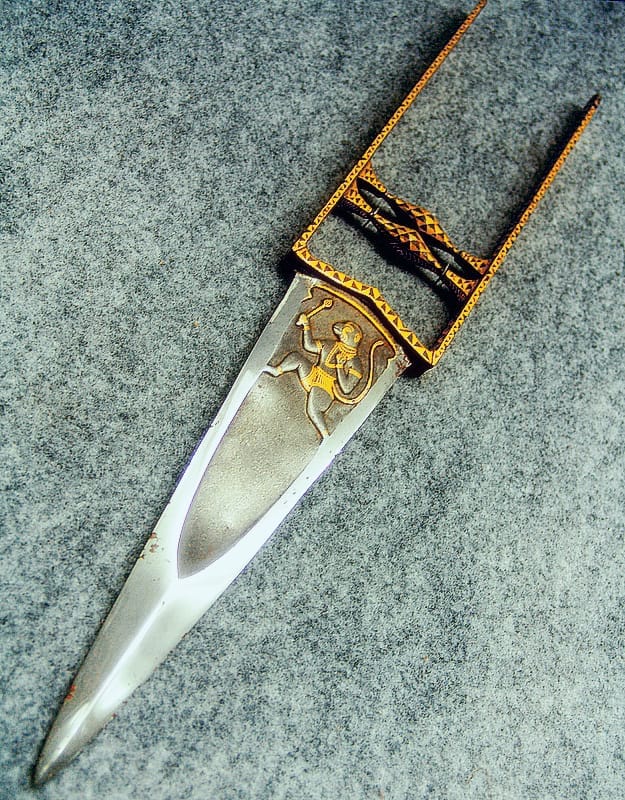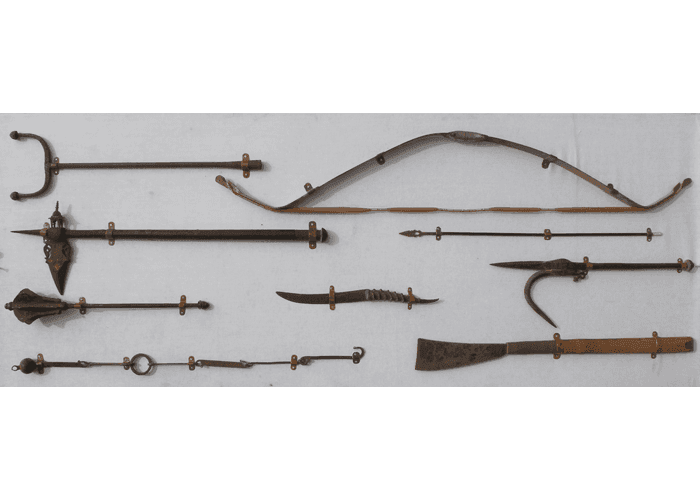Unveiling the Weapons Employed by Ancient Warriors in Rajasthan

Rajasthan Traditional Weapons (Courtesy: Mehrangarh Fort)
Introduction
Rajasthan, often hailed as the “Realm of Kings,” boasts a rich history of courage, valor, and warfare. Over the centuries, its warriors safeguarded their land and dignity using an assortment of weaponry that highlighted their combat skills and the cultural fabric of the region. Amidst grand forts and expansive battlefields, the ancient warriors of Rajasthan wielded a diverse array of weapons, each with a specific role and deeply rooted cultural significance.
1. Swords and Cutting Implements
Swords occupied a significant place in the armament of many ancient Rajput warriors. Known for their swordsmanship, these fighters had at their disposal a range of swords, each with distinctive attributes:
a. Khanda:

The khanda, a straight double-edged sword with a widening hilt, was renowned for its cutting strength and well-balanced design. It symbolized a warrior’s courage and prowess.
b. Talwar:

Featuring a gracefully curved blade, the talwar excelled in slashing and penetrating armor. Its unique shape made it a preferred choice for both mounted and infantry combat.
c. Rajput Dagger (Katar):

The katar, an exceptional dagger with an H-shaped handle, was tailor-made for thrusting and piercing. It proved remarkably effective in close-quarter combat.
2. Bows and Arrows
Archery played a pivotal role in Rajput warfare, granting warriors the ability to engage adversaries from a distance and unleash barrages of arrows. Rajputs displayed exceptional archery skills, crafting bows from materials such as bamboo and wood to achieve outstanding precision.
a. Dhanushya:
The traditional longbow, or dhanushya, constituted an essential component of a Rajput warrior’s arsenal. These bows were potent and could launch arrows over considerable distances, rendering them a formidable asset on the battlefield.

b. Ban: A compact bow, the ban, was valued for its agility, particularly in mounted combat. Rajput horsemen showcased their prowess by shooting arrows while galloping at full speed.
3. Spears and Extended Weapons
Spears and extended weapons offered versatility to Rajput warriors, enabling them to dominate the battlefield and engage adversaries at different ranges.
a. Bhala:

The bhala, a spear with a leaf-shaped blade, was used by Rajput cavalry to strike opponents from a distance while mounted on horseback.
b. Chakra:
Resembling a bladed discus, the chakra was a circular throwing weapon that demanded remarkable skill to wield effectively. It served both offensive and defensive purposes.
4. The Emergence of Firearms
As time progressed, firearms entered the realm of Rajput warfare, introducing a new dynamic to battle tactics.
a. Matchlock Musket:

In the 16th century, matchlock muskets introduced Rajput warriors to a fresh long-range capability. These firearms employed a slow-burning match cord to ignite gunpowder.
b. Cavalry Pistols:

Rajput cavalrymen occasionally wielded pistols for close combat situations. These firearms acted as secondary weapons during engagements at close quarters.
Conclusion
The weaponry embraced by ancient warriors in Rajasthan exemplified their martial prowess, bravery, and the distinctive cultural heritage of the region. From the gracefully curved talwar to the meticulously precise dhanushya, these weapons embodied honor and conquest for Rajput warriors. The enduring legacy of their martial traditions stands as a testament to the unwavering spirit that once defined the warriors of Rajasthan.









Thanks for sharing. I read many of your blog posts, cool, your blog is very good.
Can you be more specific about the content of your article? After reading it, I still have some doubts. Hope you can help me.
Thank you for your sharing. I am worried that I lack creative ideas. It is your article that makes me full of hope. Thank you. But, I have a question, can you help me?
Your point of view caught my eye and was very interesting. Thanks. I have a question for you.
Thank you for your sharing. I am worried that I lack creative ideas. It is your article that makes me full of hope. Thank you. But, I have a question, can you help me?